sensor DODGE VIPER 2017 VX / 3.G Owners Manual
[x] Cancel search | Manufacturer: DODGE, Model Year: 2017, Model line: VIPER, Model: DODGE VIPER 2017 VX / 3.GPages: 329, PDF Size: 2.83 MB
Page 38 of 329
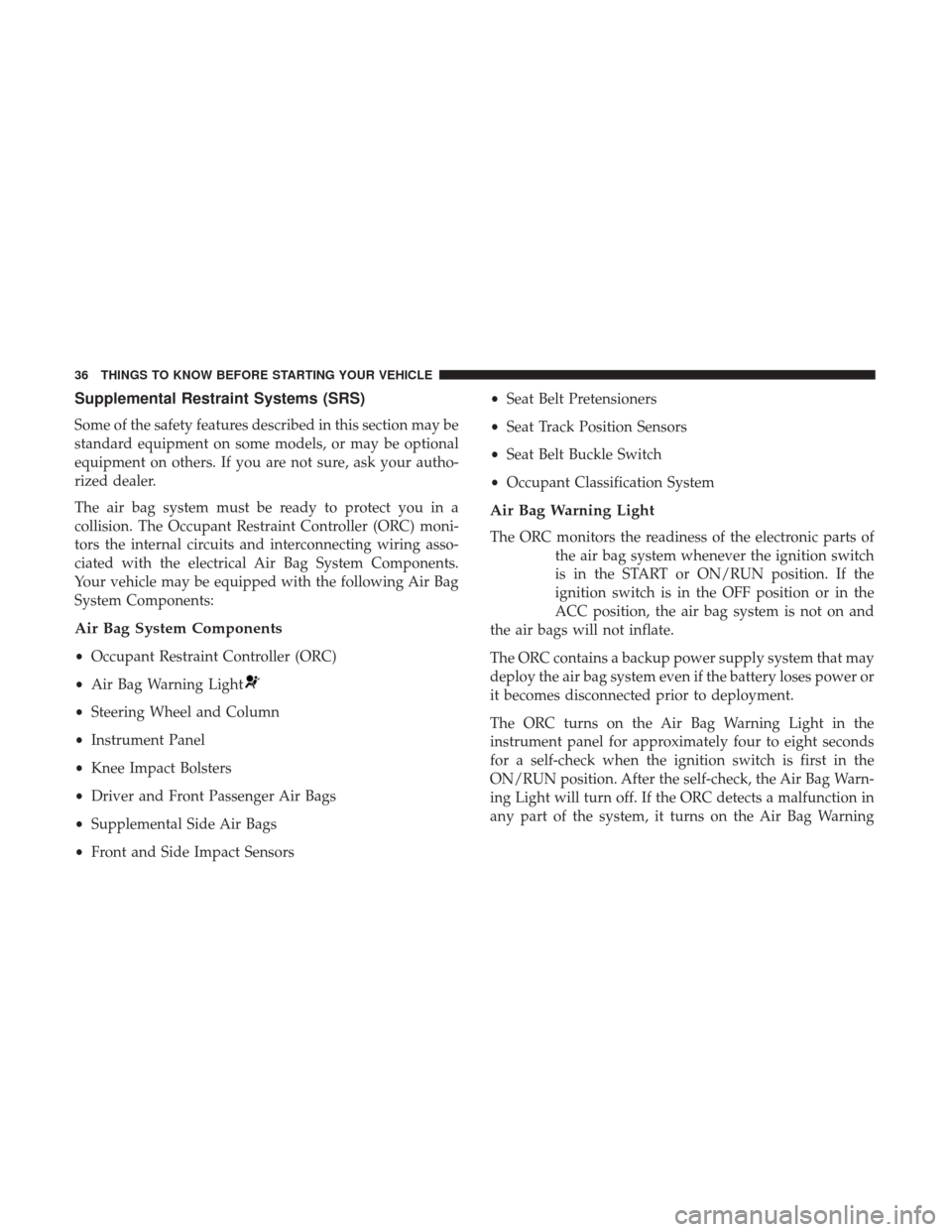
Supplemental Restraint Systems (SRS)
Some of the safety features described in this section may be
standard equipment on some models, or may be optional
equipment on others. If you are not sure, ask your autho-
rized dealer.
The air bag system must be ready to protect you in a
collision. The Occupant Restraint Controller (ORC) moni-
tors the internal circuits and interconnecting wiring asso-
ciated with the electrical Air Bag System Components.
Your vehicle may be equipped with the following Air Bag
System Components:
Air Bag System Components
•Occupant Restraint Controller (ORC)
• Air Bag Warning Light
•Steering Wheel and Column
• Instrument Panel
• Knee Impact Bolsters
• Driver and Front Passenger Air Bags
• Supplemental Side Air Bags
• Front and Side Impact Sensors •
Seat Belt Pretensioners
• Seat Track Position Sensors
• Seat Belt Buckle Switch
• Occupant Classification System
Air Bag Warning Light
The ORC monitors the readiness of the electronic parts of
the air bag system whenever the ignition switch
is in the START or ON/RUN position. If the
ignition switch is in the OFF position or in the
ACC position, the air bag system is not on and
the air bags will not inflate.
The ORC contains a backup power supply system that may
deploy the air bag system even if the battery loses power or
it becomes disconnected prior to deployment.
The ORC turns on the Air Bag Warning Light in the
instrument panel for approximately four to eight seconds
for a self-check when the ignition switch is first in the
ON/RUN position. After the self-check, the Air Bag Warn-
ing Light will turn off. If the ORC detects a malfunction in
any part of the system, it turns on the Air Bag Warning
36 THINGS TO KNOW BEFORE STARTING YOUR VEHICLE
Page 40 of 329
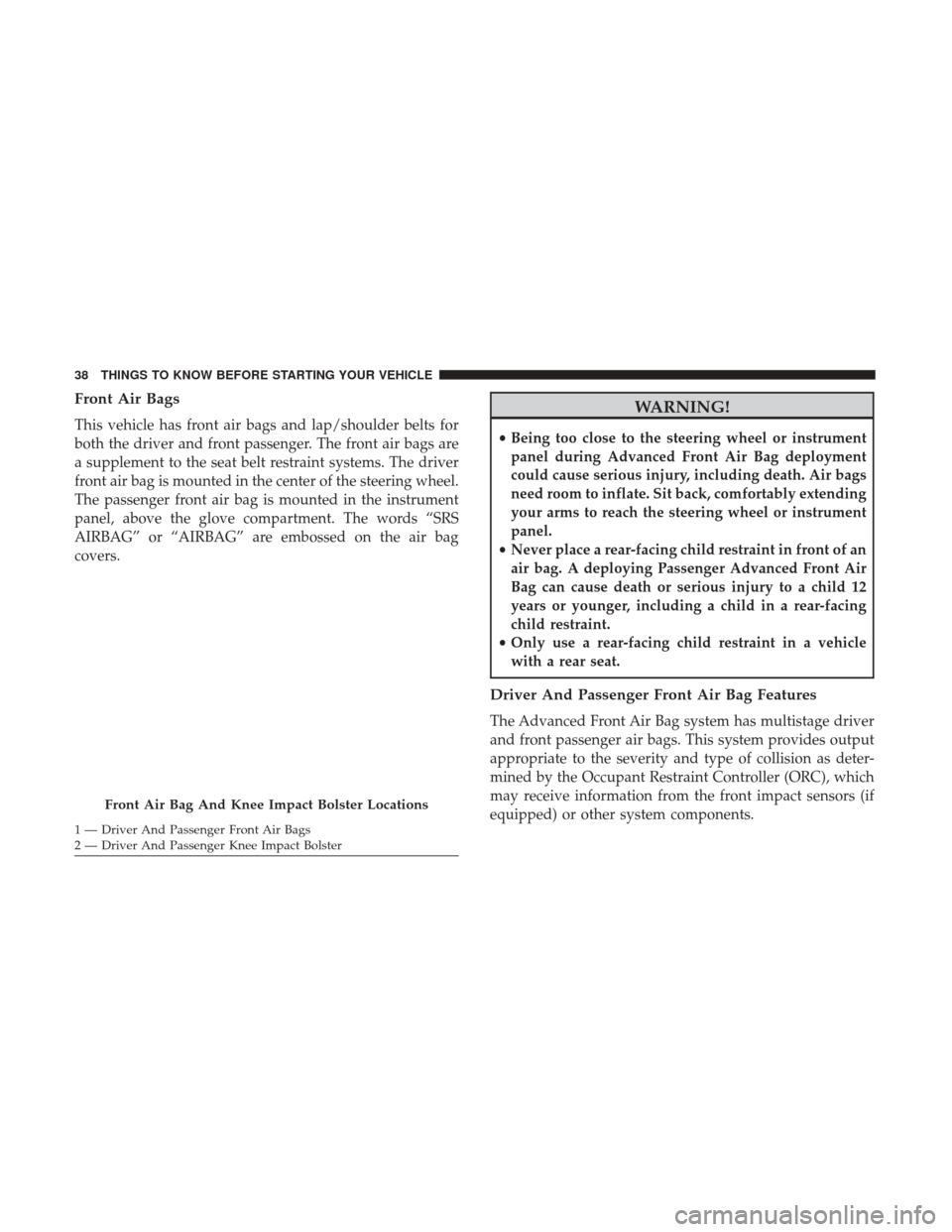
Front Air Bags
This vehicle has front air bags and lap/shoulder belts for
both the driver and front passenger. The front air bags are
a supplement to the seat belt restraint systems. The driver
front air bag is mounted in the center of the steering wheel.
The passenger front air bag is mounted in the instrument
panel, above the glove compartment. The words “SRS
AIRBAG” or “AIRBAG” are embossed on the air bag
covers.
WARNING!
•Being too close to the steering wheel or instrument
panel during Advanced Front Air Bag deployment
could cause serious injury, including death. Air bags
need room to inflate. Sit back, comfortably extending
your arms to reach the steering wheel or instrument
panel.
• Never place a rear-facing child restraint in front of an
air bag. A deploying Passenger Advanced Front Air
Bag can cause death or serious injury to a child 12
years or younger, including a child in a rear-facing
child restraint.
• Only use a rear-facing child restraint in a vehicle
with a rear seat.
Driver And Passenger Front Air Bag Features
The Advanced Front Air Bag system has multistage driver
and front passenger air bags. This system provides output
appropriate to the severity and type of collision as deter-
mined by the Occupant Restraint Controller (ORC), which
may receive information from the front impact sensors (if
equipped) or other system components.
Front Air Bag And Knee Impact Bolster Locations
1 — Driver And Passenger Front Air Bags
2 — Driver And Passenger Knee Impact Bolster 38 THINGS TO KNOW BEFORE STARTING YOUR VEHICLE
Page 41 of 329
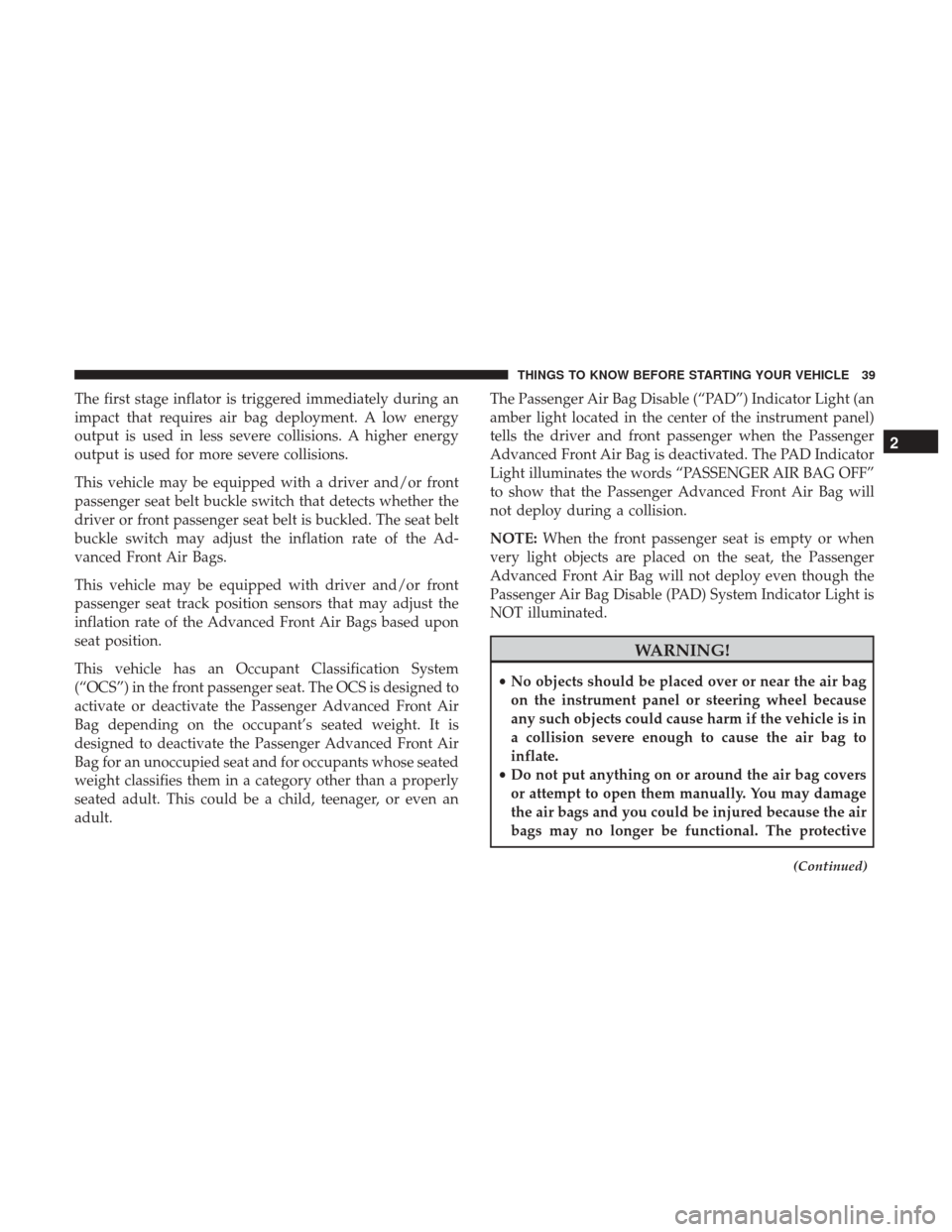
The first stage inflator is triggered immediately during an
impact that requires air bag deployment. A low energy
output is used in less severe collisions. A higher energy
output is used for more severe collisions.
This vehicle may be equipped with a driver and/or front
passenger seat belt buckle switch that detects whether the
driver or front passenger seat belt is buckled. The seat belt
buckle switch may adjust the inflation rate of the Ad-
vanced Front Air Bags.
This vehicle may be equipped with driver and/or front
passenger seat track position sensors that may adjust the
inflation rate of the Advanced Front Air Bags based upon
seat position.
This vehicle has an Occupant Classification System
(“OCS”) in the front passenger seat. The OCS is designed to
activate or deactivate the Passenger Advanced Front Air
Bag depending on the occupant’s seated weight. It is
designed to deactivate the Passenger Advanced Front Air
Bag for an unoccupied seat and for occupants whose seated
weight classifies them in a category other than a properly
seated adult. This could be a child, teenager, or even an
adult.The Passenger Air Bag Disable (“PAD”) Indicator Light (an
amber light located in the center of the instrument panel)
tells the driver and front passenger when the Passenger
Advanced Front Air Bag is deactivated. The PAD Indicator
Light illuminates the words “PASSENGER AIR BAG OFF”
to show that the Passenger Advanced Front Air Bag will
not deploy during a collision.
NOTE:
When the front passenger seat is empty or when
very light objects are placed on the seat, the Passenger
Advanced Front Air Bag will not deploy even though the
Passenger Air Bag Disable (PAD) System Indicator Light is
NOT illuminated.
WARNING!
• No objects should be placed over or near the air bag
on the instrument panel or steering wheel because
any such objects could cause harm if the vehicle is in
a collision severe enough to cause the air bag to
inflate.
• Do not put anything on or around the air bag covers
or attempt to open them manually. You may damage
the air bags and you could be injured because the air
bags may no longer be functional. The protective
(Continued)
2
THINGS TO KNOW BEFORE STARTING YOUR VEHICLE 39
Page 42 of 329
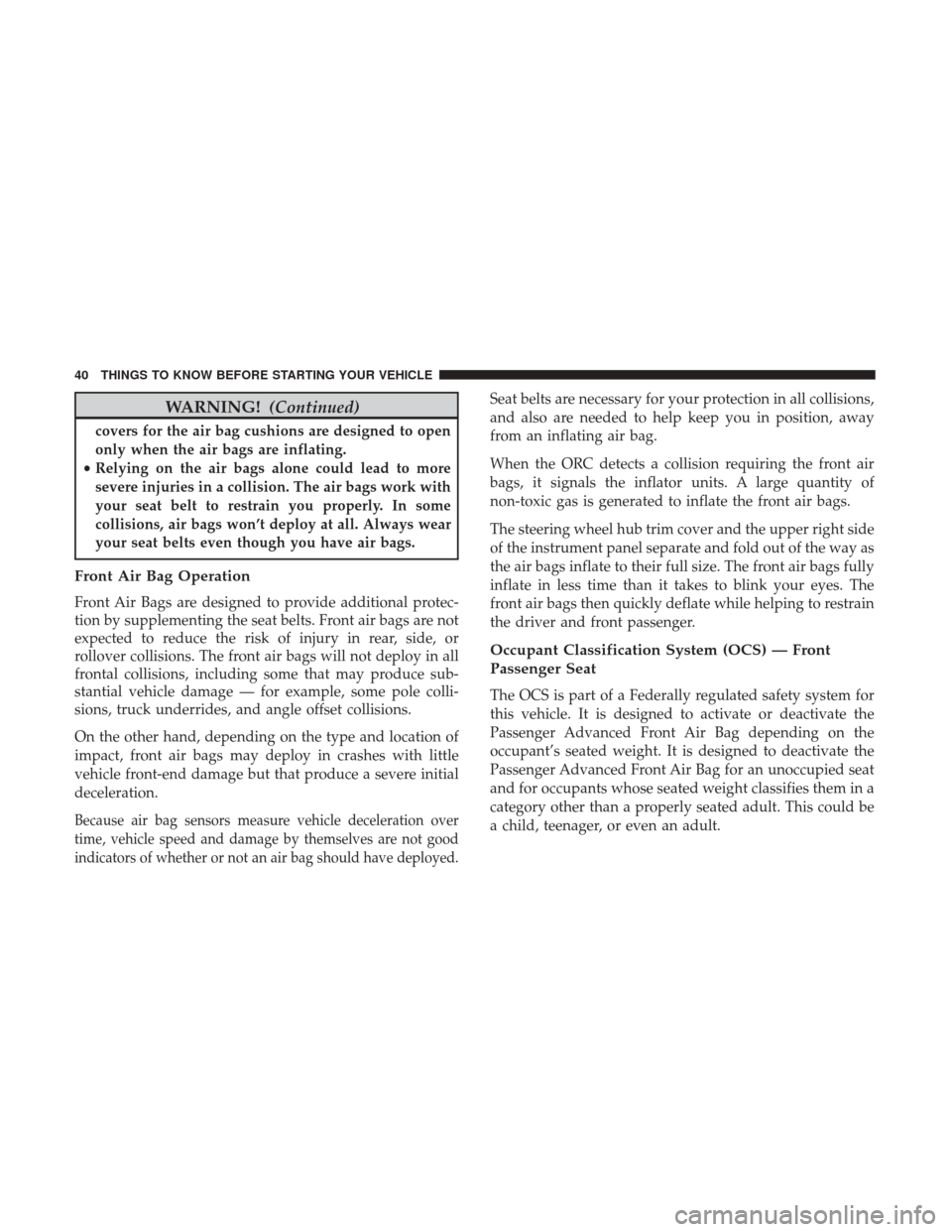
WARNING!(Continued)
covers for the air bag cushions are designed to open
only when the air bags are inflating.
• Relying on the air bags alone could lead to more
severe injuries in a collision. The air bags work with
your seat belt to restrain you properly. In some
collisions, air bags won’t deploy at all. Always wear
your seat belts even though you have air bags.
Front Air Bag Operation
Front Air Bags are designed to provide additional protec-
tion by supplementing the seat belts. Front air bags are not
expected to reduce the risk of injury in rear, side, or
rollover collisions. The front air bags will not deploy in all
frontal collisions, including some that may produce sub-
stantial vehicle damage — for example, some pole colli-
sions, truck underrides, and angle offset collisions.
On the other hand, depending on the type and location of
impact, front air bags may deploy in crashes with little
vehicle front-end damage but that produce a severe initial
deceleration.
Because air bag sensors measure vehicle deceleration over
time, vehicle speed and damage by themselves are not good
indicators of whether or not an air bag should have deployed.
Seat belts are necessary for your protection in all collisions,
and also are needed to help keep you in position, away
from an inflating air bag.
When the ORC detects a collision requiring the front air
bags, it signals the inflator units. A large quantity of
non-toxic gas is generated to inflate the front air bags.
The steering wheel hub trim cover and the upper right side
of the instrument panel separate and fold out of the way as
the air bags inflate to their full size. The front air bags fully
inflate in less time than it takes to blink your eyes. The
front air bags then quickly deflate while helping to restrain
the driver and front passenger.
Occupant Classification System (OCS) — Front
Passenger Seat
The OCS is part of a Federally regulated safety system for
this vehicle. It is designed to activate or deactivate the
Passenger Advanced Front Air Bag depending on the
occupant’s seated weight. It is designed to deactivate the
Passenger Advanced Front Air Bag for an unoccupied seat
and for occupants whose seated weight classifies them in a
category other than a properly seated adult. This could be
a child, teenager, or even an adult.
40 THINGS TO KNOW BEFORE STARTING YOUR VEHICLE
Page 43 of 329
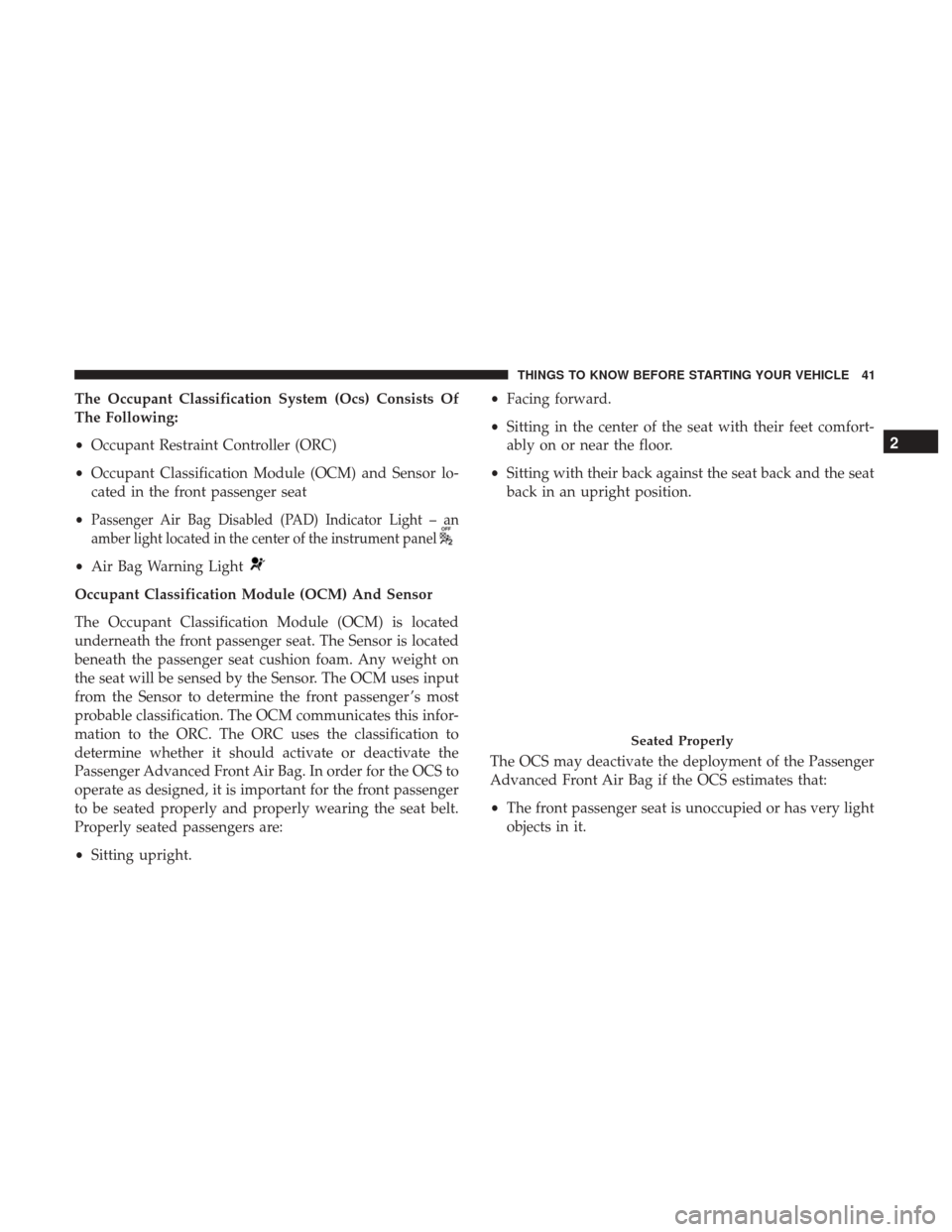
The Occupant Classification System (Ocs) Consists Of
The Following:
•Occupant Restraint Controller (ORC)
• Occupant Classification Module (OCM) and Sensor lo-
cated in the front passenger seat
•
Passenger Air Bag Disabled (PAD) Indicator Light – an
amber light located in the center of the instrument panel
• Air Bag Warning Light
Occupant Classification Module (OCM) And Sensor
The Occupant Classification Module (OCM) is located
underneath the front passenger seat. The Sensor is located
beneath the passenger seat cushion foam. Any weight on
the seat will be sensed by the Sensor. The OCM uses input
from the Sensor to determine the front passenger ’s most
probable classification. The OCM communicates this infor-
mation to the ORC. The ORC uses the classification to
determine whether it should activate or deactivate the
Passenger Advanced Front Air Bag. In order for the OCS to
operate as designed, it is important for the front passenger
to be seated properly and properly wearing the seat belt.
Properly seated passengers are:
•Sitting upright. •
Facing forward.
• Sitting in the center of the seat with their feet comfort-
ably on or near the floor.
• Sitting with their back against the seat back and the seat
back in an upright position.
The OCS may deactivate the deployment of the Passenger
Advanced Front Air Bag if the OCS estimates that:
• The front passenger seat is unoccupied or has very light
objects in it.
Seated Properly
2
THINGS TO KNOW BEFORE STARTING YOUR VEHICLE 41
Page 52 of 329
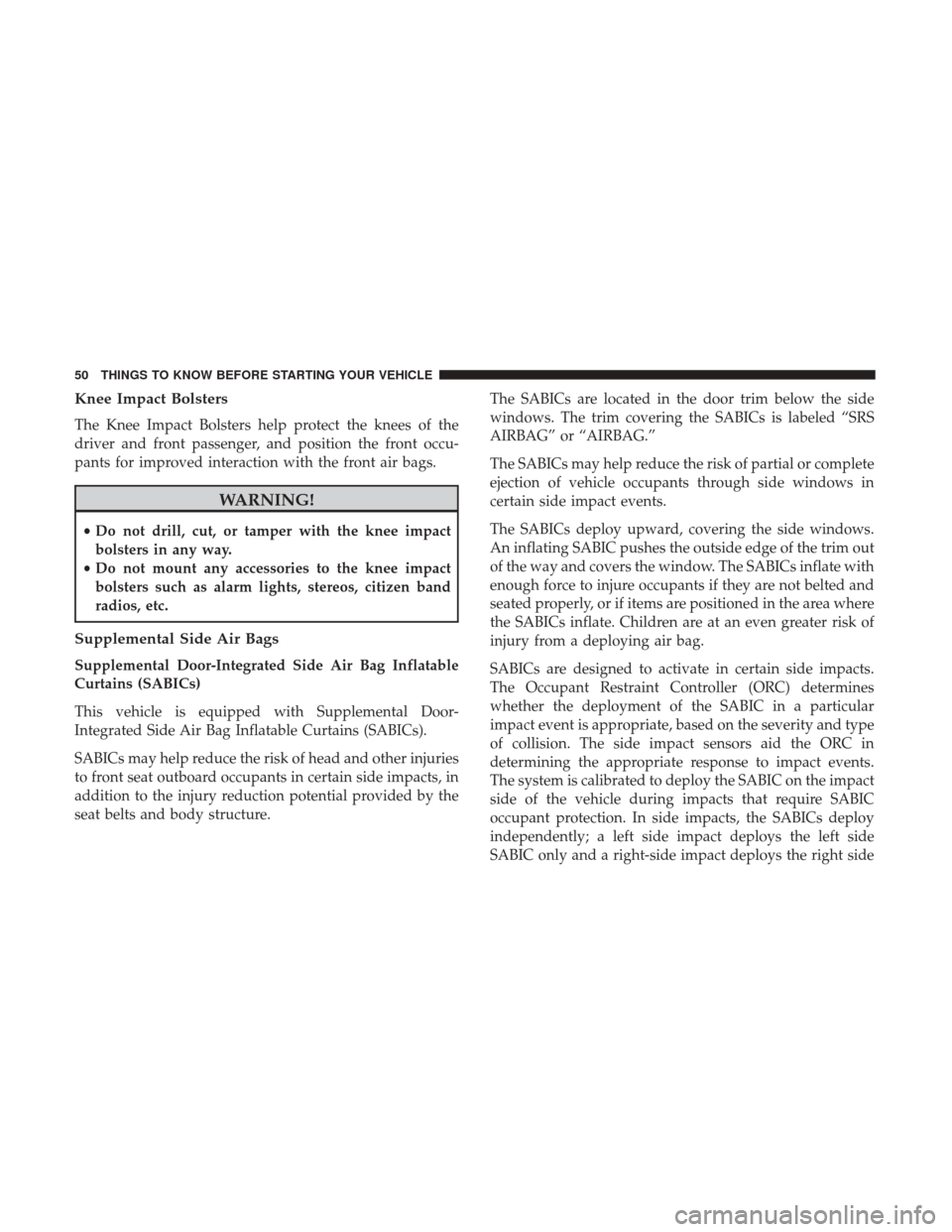
Knee Impact Bolsters
The Knee Impact Bolsters help protect the knees of the
driver and front passenger, and position the front occu-
pants for improved interaction with the front air bags.
WARNING!
•Do not drill, cut, or tamper with the knee impact
bolsters in any way.
• Do not mount any accessories to the knee impact
bolsters such as alarm lights, stereos, citizen band
radios, etc.
Supplemental Side Air Bags
Supplemental Door-Integrated Side Air Bag Inflatable
Curtains (SABICs)
This vehicle is equipped with Supplemental Door-
Integrated Side Air Bag Inflatable Curtains (SABICs).
SABICs may help reduce the risk of head and other injuries
to front seat outboard occupants in certain side impacts, in
addition to the injury reduction potential provided by the
seat belts and body structure. The SABICs are located in the door trim below the side
windows. The trim covering the SABICs is labeled “SRS
AIRBAG” or “AIRBAG.”
The SABICs may help reduce the risk of partial or complete
ejection of vehicle occupants through side windows in
certain side impact events.
The SABICs deploy upward, covering the side windows.
An inflating SABIC pushes the outside edge of the trim out
of the way and covers the window. The SABICs inflate with
enough force to injure occupants if they are not belted and
seated properly, or if items are positioned in the area where
the SABICs inflate. Children are at an even greater risk of
injury from a deploying air bag.
SABICs are designed to activate in certain side impacts.
The Occupant Restraint Controller (ORC) determines
whether the deployment of the SABIC in a particular
impact event is appropriate, based on the severity and type
of collision. The side impact sensors aid the ORC in
determining the appropriate response to impact events.
The system is calibrated to deploy the SABIC on the impact
side of the vehicle during impacts that require SABIC
occupant protection. In side impacts, the SABICs deploy
independently; a left side impact deploys the left side
SABIC only and a right-side impact deploys the right side
50 THINGS TO KNOW BEFORE STARTING YOUR VEHICLE
Page 54 of 329
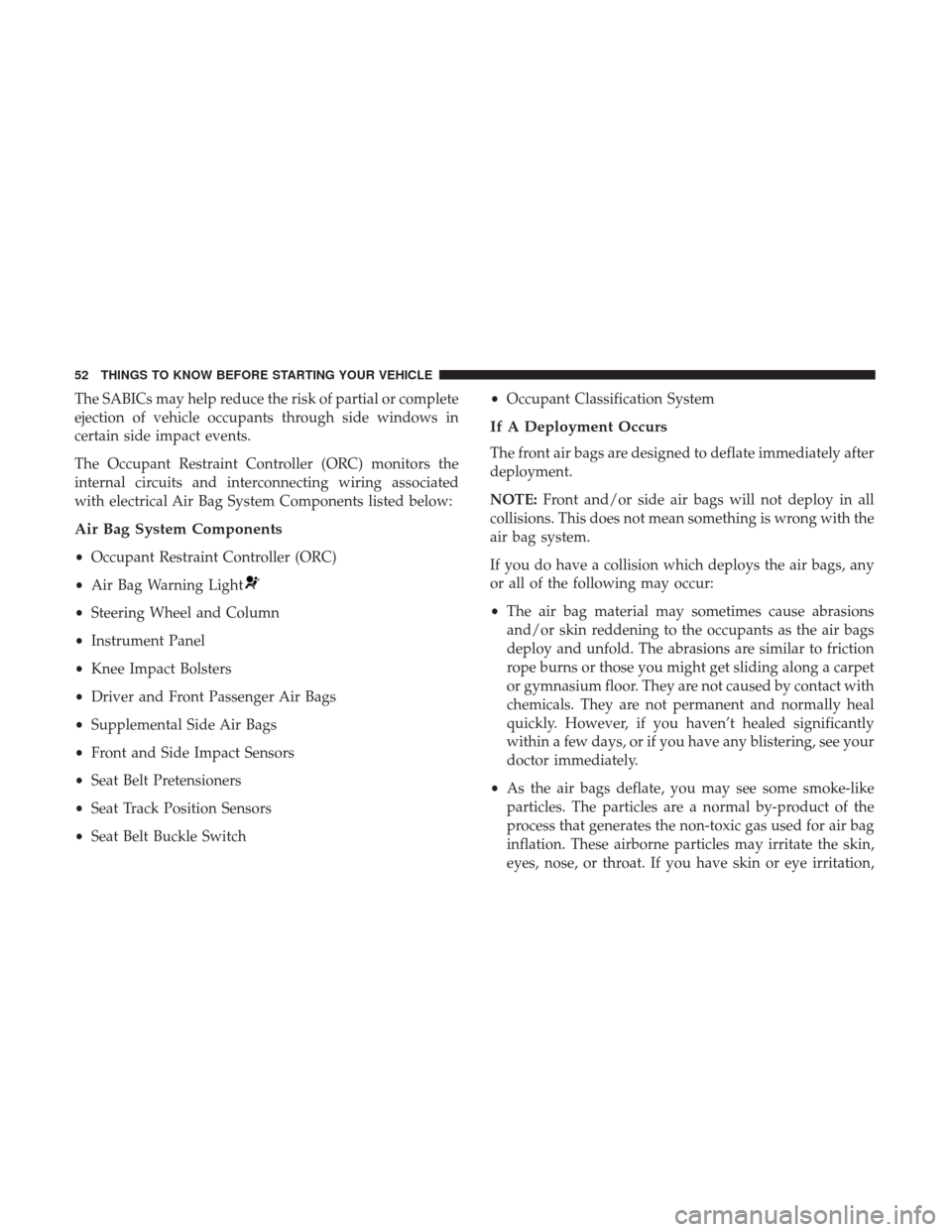
The SABICs may help reduce the risk of partial or complete
ejection of vehicle occupants through side windows in
certain side impact events.
The Occupant Restraint Controller (ORC) monitors the
internal circuits and interconnecting wiring associated
with electrical Air Bag System Components listed below:
Air Bag System Components
•Occupant Restraint Controller (ORC)
• Air Bag Warning Light
•Steering Wheel and Column
• Instrument Panel
• Knee Impact Bolsters
• Driver and Front Passenger Air Bags
• Supplemental Side Air Bags
• Front and Side Impact Sensors
• Seat Belt Pretensioners
• Seat Track Position Sensors
• Seat Belt Buckle Switch •
Occupant Classification System
If A Deployment Occurs
The front air bags are designed to deflate immediately after
deployment.
NOTE: Front and/or side air bags will not deploy in all
collisions. This does not mean something is wrong with the
air bag system.
If you do have a collision which deploys the air bags, any
or all of the following may occur:
• The air bag material may sometimes cause abrasions
and/or skin reddening to the occupants as the air bags
deploy and unfold. The abrasions are similar to friction
rope burns or those you might get sliding along a carpet
or gymnasium floor. They are not caused by contact with
chemicals. They are not permanent and normally heal
quickly. However, if you haven’t healed significantly
within a few days, or if you have any blistering, see your
doctor immediately.
• As the air bags deflate, you may see some smoke-like
particles. The particles are a normal by-product of the
process that generates the non-toxic gas used for air bag
inflation. These airborne particles may irritate the skin,
eyes, nose, or throat. If you have skin or eye irritation,
52 THINGS TO KNOW BEFORE STARTING YOUR VEHICLE
Page 129 of 329
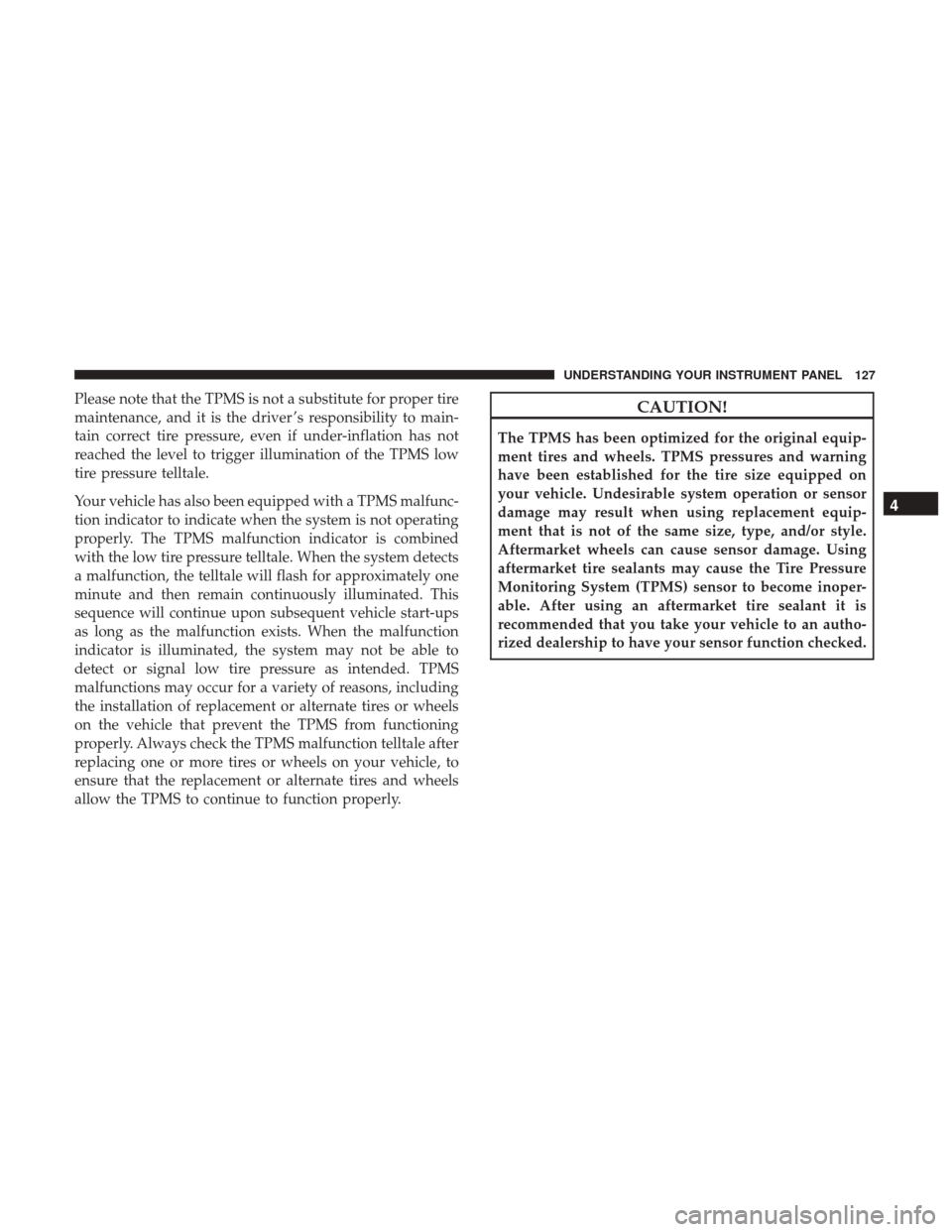
Please note that the TPMS is not a substitute for proper tire
maintenance, and it is the driver ’s responsibility to main-
tain correct tire pressure, even if under-inflation has not
reached the level to trigger illumination of the TPMS low
tire pressure telltale.
Your vehicle has also been equipped with a TPMS malfunc-
tion indicator to indicate when the system is not operating
properly. The TPMS malfunction indicator is combined
with the low tire pressure telltale. When the system detects
a malfunction, the telltale will flash for approximately one
minute and then remain continuously illuminated. This
sequence will continue upon subsequent vehicle start-ups
as long as the malfunction exists. When the malfunction
indicator is illuminated, the system may not be able to
detect or signal low tire pressure as intended. TPMS
malfunctions may occur for a variety of reasons, including
the installation of replacement or alternate tires or wheels
on the vehicle that prevent the TPMS from functioning
properly. Always check the TPMS malfunction telltale after
replacing one or more tires or wheels on your vehicle, to
ensure that the replacement or alternate tires and wheels
allow the TPMS to continue to function properly.CAUTION!
The TPMS has been optimized for the original equip-
ment tires and wheels. TPMS pressures and warning
have been established for the tire size equipped on
your vehicle. Undesirable system operation or sensor
damage may result when using replacement equip-
ment that is not of the same size, type, and/or style.
Aftermarket wheels can cause sensor damage. Using
aftermarket tire sealants may cause the Tire Pressure
Monitoring System (TPMS) sensor to become inoper-
able. After using an aftermarket tire sealant it is
recommended that you take your vehicle to an autho-
rized dealership to have your sensor function checked.
4
UNDERSTANDING YOUR INSTRUMENT PANEL 127
Page 209 of 329

Electronic Stability Control
In full on mode the TCS system enhances directional
control and stability of the vehicle under various driving
conditions. The ESC corrects for oversteering and under-
steering the vehicle by applying the brake of the appropri-
ate wheel. Engine power may also be reduced to assist in
counteracting the condition of oversteer or understeer and
help the vehicle maintain the desired path.
In full on mode ESC utilizes sensors in the vehicle to
determine the path that the driver intends to steer the
vehicle and compares it to the actual path of the vehicle.
When the actual path does not match the intended path,
the ESC applies the brake of the appropriate wheel to assist
in counteracting the condition of oversteer or understeer.
•Oversteer – when the vehicle is turning more than
appropriate for the steering wheel position.
• Understeer – when the vehicle is turning less than
appropriate for the steering wheel position.
WARNING!
The Electronic Stability Control System (ESC) cannot
prevent the natural laws of physics from acting on the
vehicle, nor can it increase the traction afforded by
prevailing road conditions. ESC cannot prevent all
accidents, including those resulting from excessive
speed in turns, driving on very slippery surfaces, or
hydroplaning. ESC also cannot prevent accidents re-
sulting from loss of vehicle control due to inappropri-
ate driver input for the conditions. Only a safe, atten-
tive, and skillful driver can prevent accidents. The
capabilities of an ESC equipped vehicle must never be
exploited in a reckless or dangerous manner which
could jeopardize the user ’s safety or the safety of
others.
5
STARTING AND OPERATING 207
Page 231 of 329
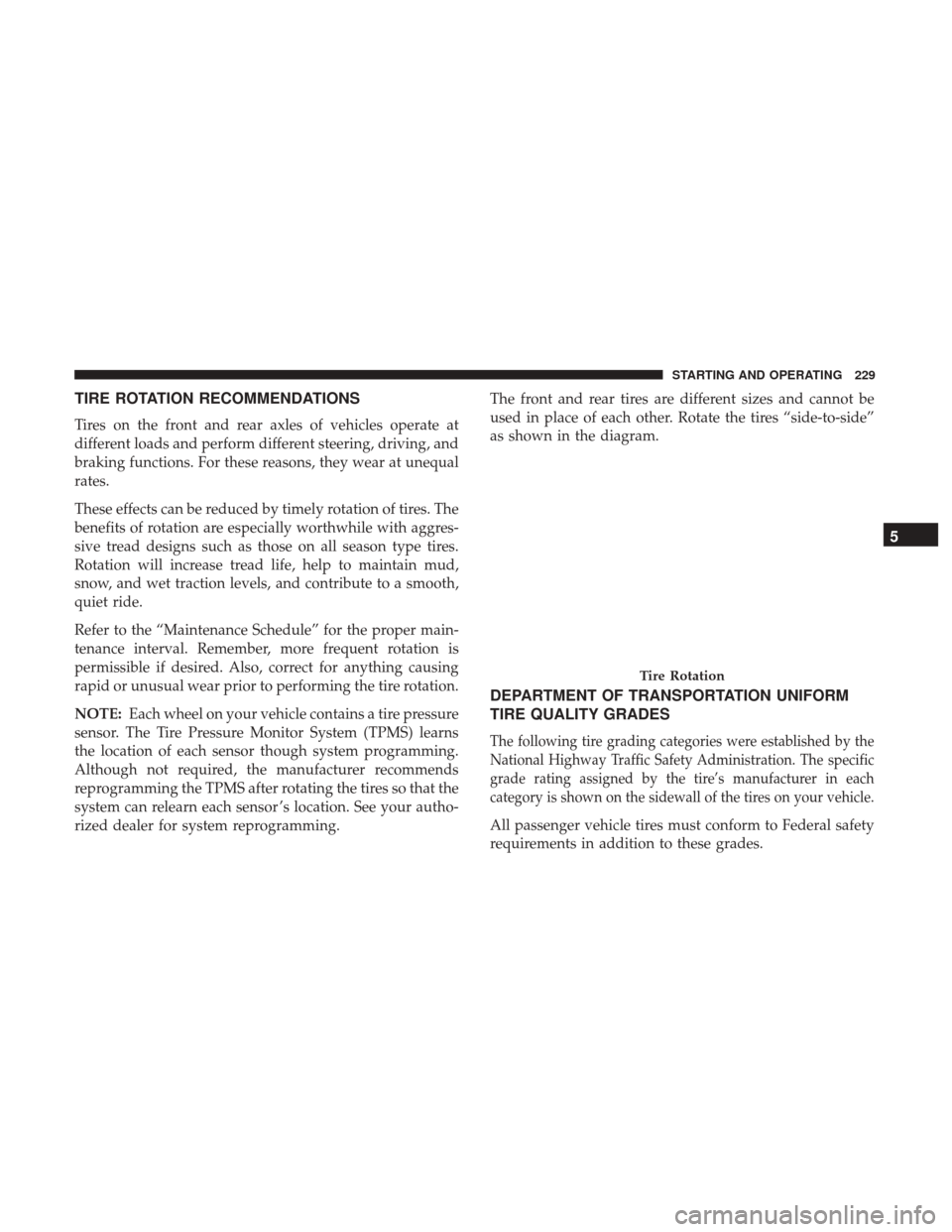
TIRE ROTATION RECOMMENDATIONS
Tires on the front and rear axles of vehicles operate at
different loads and perform different steering, driving, and
braking functions. For these reasons, they wear at unequal
rates.
These effects can be reduced by timely rotation of tires. The
benefits of rotation are especially worthwhile with aggres-
sive tread designs such as those on all season type tires.
Rotation will increase tread life, help to maintain mud,
snow, and wet traction levels, and contribute to a smooth,
quiet ride.
Refer to the “Maintenance Schedule” for the proper main-
tenance interval. Remember, more frequent rotation is
permissible if desired. Also, correct for anything causing
rapid or unusual wear prior to performing the tire rotation.
NOTE:Each wheel on your vehicle contains a tire pressure
sensor. The Tire Pressure Monitor System (TPMS) learns
the location of each sensor though system programming.
Although not required, the manufacturer recommends
reprogramming the TPMS after rotating the tires so that the
system can relearn each sensor ’s location. See your autho-
rized dealer for system reprogramming. The front and rear tires are different sizes and cannot be
used in place of each other. Rotate the tires “side-to-side”
as shown in the diagram.
DEPARTMENT OF TRANSPORTATION UNIFORM
TIRE QUALITY GRADES
The following tire grading categories were established by the
National Highway Traffic Safety Administration. The specific
grade rating assigned by the tire’s manufacturer in each
category is shown on the sidewall of the tires on your vehicle.
All passenger vehicle tires must conform to Federal safety
requirements in addition to these grades.
Tire Rotation
5
STARTING AND OPERATING 229